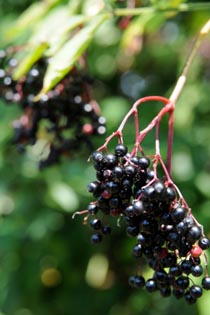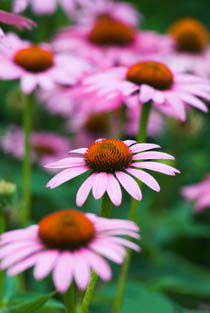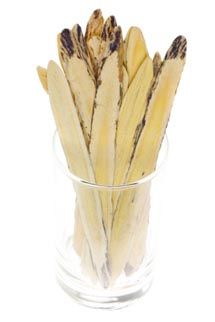Now that pumpkin carving is giving way to thoughts of pumpkin pie, something else might turn up on your plate that leaves little to be thankful for – like a head cold, or worse, the flu. Don’t let a few germs hamper your holiday festivities! With a few herbal allies, you can stifle the sniffles before they get started.
Technically known as acute coryza, viral rhinopharyngitis or nasopharyngitis, the common cold is caused by coronaviruses and rhinoviruses moving into your nose and upper respiratory system, producing fever, cough, a runny nose and sore throat. Since there are at least 100 strains that seek out human companionship, trying to dodge them all season isn’t likely to be a successful strategy. Similarly, various strains of influenza -- the virus responsible for causing the flu – cleverly and rapidly morph into new combinations to escape the effectiveness of anti-viral drugs and wreak havoc on your immune system. Fortunately, nature provides medicines to help prevent such viral assaults without the need for an injection or a prescription.
Elderberry (Sambucus nigra)

Also known as bore tree and as simply elder, elderberry is a flowering shrub that yields dark purple fruits and white flowers, both of which have been used for centuries to make syrups, marmalades, wines, liquors and cordials. The stems of the bush are traditionally hollowed out and used to tap syrup from maple trees or as impromptu pipes or pop-guns to amuse children. However, you would be wise to first ask permission of the tree before making a cut since Dutch folklore cautions that Hylde-Moer, or the Elder Mother, resides among the branches. Otherwise, neglecting this formality would invite the tree spirit to inhabit whatever object the wood was used to make and haunt the person who dared to harvest it.
Elderberry has also been used for generations to remedy cold and flu, a purpose supported by modern science. In fact, studies show that elderberry combats viruses that cause sniffles in multiple ways. Chemical components in the berries, such as the flavonoids rutin and quercetin, neutralize viral hemagglutinin, the enzyme secreted by the spiral projections that line the surface of viral cells. Without this intervention, the virus would successfully penetrate the membranes of the healthy cells in your body and reproduce itself. A 2001 study found that elderberry stimulates immune function by increasing production of signaling proteins called cytokines. Several studies show that elderberry is effective against at least 10 different strains of influenza. According to a study published in “Phytochemistry” in 2009, elderberry compounds are as effective against the influenza A H1N1 virus as Tamiflu.
Note that the leaves, stems and flowers of elderberry contain glycosides that synthesize cyanide as a byproduct of metabolism. In large amounts, this could produce toxicity, so don’t ingest these materials. The berries, however, are safe to use to make elderberry tea, syrup or extract.
Echinacea (Echinacea sp.)

Also known as coneflower, echinacea was commonly used by various North American native peoples to counter colds and flu, especially E. angustifolia and E. purpurea. Like elderberry, echinacea goes to work in different ways. Various alkamide compounds, polysaccharides, glycoproteins and caffeic acid derivatives in the plant are collectively responsible for the herb’s antibacterial, anti-inflammatory and immuno-stimulatory properties. Studies have shown that echinacea extracts increase T-cell activity by as much as 40 percent, including their ability to destroy invading viral enzymes in a process known as phagocytosis. Echinacea also enhances chemotaxis, which translates to a greater concentration of various disease-fighting immune system cells in circulation. The herb also increases the release of leukocytes, immune system chemicals secreted by lymph glands that seek out and destroy foreign materials.
According to the University of Maryland Medical Center, a review of 14 clinical trials shows that echinacea lowers the risk of “catching” a cold by 58 percent The same review also concludes that the herb reduces the severity and duration of symptoms in people already infected by several days. Although several species of echinacea promote similar affects because they contain similar chemical compounds, Echinacea purpurea appears to be the most effective.
Astragalus (Astragalus membranaceus)

Astragalus, also known as huang qi, has been used in Traditional Chinese medicine for thousands of years to restore homeostasis, or the ability of the body to maintain internal stability. For this reason, the herb is referred to as an adaptogen, which means it helps to body to restore balance while undergoing physical or emotional stress.
The medicinal part of the plant is the root, which contains various flavonoids and several amino acids, fatty acids, saponins and polysaccharides that promote antioxidant, antiviral and immuno-stimulating properties. Studies show that astragalus root preparations are active against human rhinoviruses. The herb also appears to enhance immune function. In fact, although results are mixed so far, astragalus continues to be studied as a potential therapy for people with compromised immune systems due to chemotherapy or infection with HIV.
Astragalus may produce diuretic effects, so don’t use this herb with medications that increase urine flow. Also, consult your physician before using this herb if you have an autoimmune disease and take medications to suppress immune function because the herb may increase the effects of these drugs.
References
Phytochemistry: Elderberry Flavonoids Bind to and Prevent H1N1 Infection in vitro; July 2009
http://www.ncbi.nlm.nih.gov/pubmed/19682714
European Cytokine Network: The Effect of Sambucol, a Black Elderberry-Based, Natural Product, on the Production of Human Cytokines: I. Inflammatory Cytokines; Apr-June 2001
http://www.ncbi.nlm.nih.gov/pubmed/11399518
